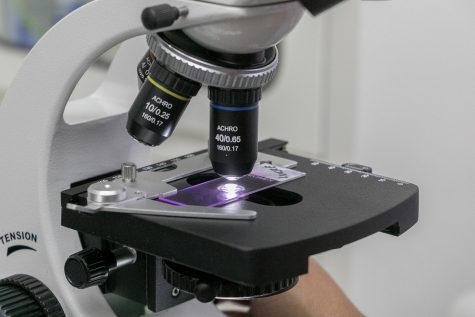Holocaust survivor shares her story as part of annual lecture series
Celie Lackner Heinish Halzel spoke to 150 people on growing up in the 1930s.
January 22, 2018
At a Canadian museum in Halifax, Nova Scotia, is the Sobey Wall of Honour, where silver plaques hang, bearing hundreds of names. Each name tells a story, the narrative of an immigrant stepping onto Canadian soil and beginning a new life — and among these names are Celie Lackner Heinish Halzel, her sister Blanca Lackner Heinish Jacobs, and her aunt Pearl Apel — all survivors of the Holocaust.
To commemorate a 10th annual lecture series, Halzel told her story of struggle, rebirth, and hope to 150 people in the Boca campus Performing Arts building on Jan. 14. The lecture was sponsored by the College of Arts and Letters.
“To this day, the Holocaust survivors I know spend their time sharing their memories with young people, not for the sake of revenge, but its opposite — to teach tolerance and the value of life,” she said. “We remember the past not to be held captive, but rather to turn it into a blessing and a source of hope.”
Halzel’s history
Halzel was born in 1939 in Radautz, Romania to a middle class family who owned a factory. Most of the 1930s seemed safe and secure, Halzel said, and few among the Jewish population could believe that their lives would be impacted so drastically so soon.
Before the “rumblings of war,” some of the people were leaving for Palestine, Canada, or America, but her family with two small children remained, hoping that things would soon even out, Halzel said.
“But as we now know, life never returned to normal for the Jews in Europe, and most definitely not for us in Raduitz,” Halzel said.
From 1938-40, Romania came increasingly under German power, and the Jews of Raduitz, Halzel’s family among them, were deported to prison camps. Her family ended up in Mogilev, where they would remain from May 1941 to June 1944. Halzel was 2 years old at the time.
Many died before reaching the camps, Halzel said, but conditions did not improve once they were there — many more were to die from disease, hunger, and ruthless treatment. The people of the camp lived crowded together, and food consisted of what they called “potato soup,” which in reality was only limp potato peels in water.
“For years I bore the evidence of malnutrition. However, hunger was not nearly as hard to bear as was the loss of my parents,” Halzel said.
Her father was a diabetic, and his body could not hold up without medication. Her mother died shortly after from influenza. Halzel still grieves that she was not even given a proper burial, saying, “Her body was simply bulldozed into the ground.”
Her Aunt Pearl took the responsibility of caring for Halzel and her sister, Blanca, after the passing of their parents, looking over their safety in the confines of the camp and beyond.
When the order came one day for their section to gather their belongings and board a waiting cattle train, Halzel’s Aunt Pearl knew that they must somehow avoid it. She came up with a plan, bribing the guard with her last bit of gold jewelry to ensure their escape.
“Miraculously, the guard took the jewelry and let us slip away. And my Aunt pearl was right. The train was on its way to Auschwitz, and those who were forced to remain on the train all perished,” Halzel said.
Halzel returns home
The German defeat at Stalingrad in 1943 prevented the Nazis from their quest to kill all Romanian Jews, and the time to go home had finally come.
Only 2,000 of the 8,000 survived the labor camps and returned to Raduitz, Hazel said, “sick in body in soul.” They came back to destroyed homes and splintered possessions, ghosts of their former lives.
“I can’t even imagine how my Aunt Pearl, traveling by foot in the cold with two little girls, managed to get us back to our hometown — a distance of 500 miles. I have been blessed to have many guardian angels in my life. My Aunt Pearl was the first,” Halzel said.
Help came from Halzel’s cousin Noah and his wife Sarah in Halifax, Nova Scotia, Canada, who worked for JIAS, the Jewish Immigration Aid Society. From 1944-47, immigration documents were obtained and arrangements were finalized — but only for Halzel and her sister. Aunt Pearl had to remain in Romania for almost another year before her immigration papers were cleared.
Halzel and her sister spent six months in a temporary refugee shelter, Camp Rothschild in Vienna, for six months before the S.S. Sturgis became available to board. There, they were the two youngest orphans in a total number of 2,000 that made the journey from Bremerhaven, Germany, to the port of Halifax, Nova Scotia, Canada.
In February 1948, Halzel, at 8 years old, finally got her first glimpse of the city which was to become her new home. Her cousin Noah greeted them in Yiddish, and Sarah bundled them up in warm clothing, giving them a hug and taking them home, Halzel said. The two would officially adopt Halzel and her sister a year later.
“I think of Halifax as my home, and Canada as the country of my rebirth,” Halzel said. She and her sister would come to think of this new home as the Garden of Eden, she added, their step out of the depths and into the light.
Halzel continued to grow up in Canada with her new parents, who taught her to not dwell on the past, but instead to pick up the pieces and move on.
As for her birth parents, she believes they would’ve said this: “You can cry, close your eyes, be empty, turn your back, or you can do what we would want you to do — smile, open your eyes, love, and go on. And go on is what we did.”
When the time came to choose a profession, Halzel chose Jewish education. Nobody spoke about the Holocaust in any form of education for quite a while, she said, for fear of frightening the children and causing a stir among the parents. This rhetoric came to change as Jewish educators began to realize that the remaining survivors would eventually be gone, and that it’s up to the next generation to pass along the message.
“If history teaches us anything, it’s a very simple rule — out of the ashes, something new and beautiful can emerge.”
In Halzel’s words
“In my heart I know these are the children who will pass on our stories, and they will stand up and say loud and strong, ‘never again.”
“I have to admit that as a Holocaust survivor, there have been times when I have felt angry and discouraged recalling the events which shaped my destiny, but then I look at my four precious grandchildren, all graduates of Jewish day schools, the next generation in a link unbroken, and I think — no Hitler. Your final solution did not, and will never work.”
“And I look at my husband, who has devoted over 40 years of his life ensuring quality Jewish education for the children who will be the Jewish leaders of the future, and I think — no Hitler. Your final solution did not, and will never work.”
“And I remember fondly the hundreds of children in my classes over the 42 years that I taught, whose lives I have been privileged to touch, as together we studied Hebrew language and Jewish language, and I think — no Hitler. Your final solution did not, and will never work.”
“And so I stop feeling angry and discouraged. Instead, I am thankful and only hope that I have lived and will continue to live each day of my life in such a way as to deserve to have survived when so many others who were also deserving did not.”
Hope Dean is the features editor of the University Press. For information regarding this or other stories, email [email protected].

















Jan Schwartz • Feb 22, 2019 at 2:56 pm
Just wanted to say “bravo” to Hope Dean for a beautifully written article. We know Celie from Temple Anshei Shalom and that she was a survivor but had never heard her whole story. Thank you for telling it so well!